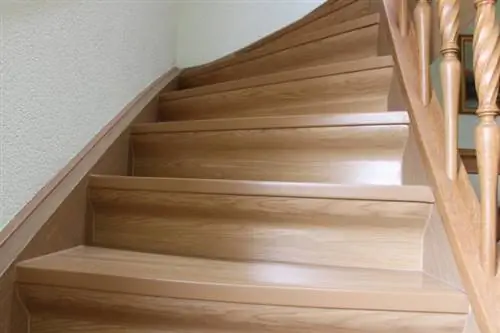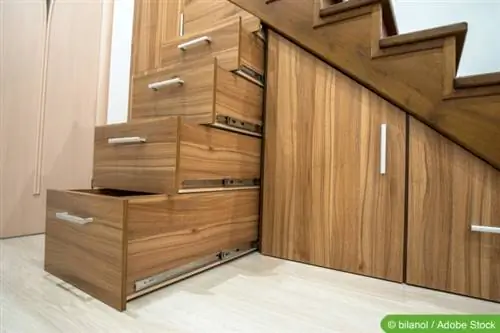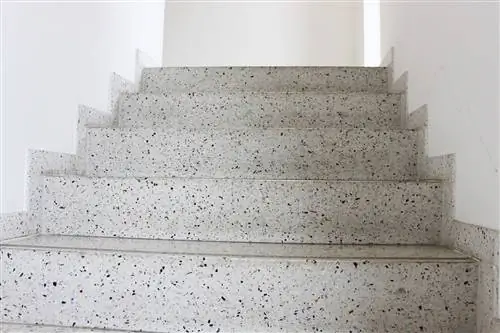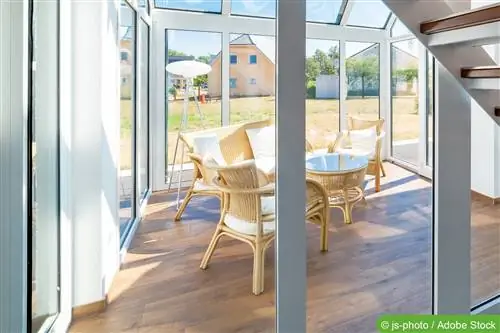- Author admin [email protected].
- Public 2023-12-17 03:39.
- Last modified 2025-01-24 12:45.
Of course, real estate agents, house sellers or landlords want to specify the living space of an apartment or house as high as possible, as this drives up the price. But is it even permissible to include stairs in the calculation? Read here whether the stairwell counts as living space.
Staircase in an apartment building
In general, the stairwell outside an apartment in an apartment building is not counted as living space because it primarily serves as a transit area and has no residential function. It is a common area used by all residents of a building. They use the stairwell to gain access to their respective apartments.

Note:
Living area usually refers to the area within the walls of an apartment. The stairwell within an apartment building, on the other hand, is one of the so-called circulation areas.
Stairs within an apartment / single-family house
However, the calculation of stairs as part of the living space within an apartment or single-family home is a little more complicated. It also depends on the legal basis on which this was calculated. In addition, the size of the stairs or stairwell determines whether they actually count as part of the living space.
Living Space Ordinance (WoFlV)
The living space normally includes all rooms within the apartment that can be used for residential purposes. These include the bedroom and living room, the study as well as the bathroom and kitchen. Rooms located outside of an apartment, for example in the attic, in the basement, etc., are usually considered usable areas. However, they are not relevant for calculating the living space. According to the living space regulations, these regulations apply to stairs:

- Stairs with more than three steps do not count as living space
- must be deducted from the total area instead
- Stairs with fewer than three steps count as 100 percent of the living space
- Requirement: Room height is at least two meters
The Living Space Ordinance is important for homeowners because it is relevant for calculating property tax.
Tip:
Balconies and terraces, on the other hand, always count as part of the living space, but are usually not 100 percent included in the calculation (25 percent according to WoFIV, 50 percent according to DIN 277).
DIN standard 277
Even according to DIN 277, stairs are not part of the living space. This standard defines the division of areas into different types of use such as
- Living space
- Traffic area
- Usable area
- or accessory rooms / adjoining rooms (e.g. drying room, laundry room, storage room, etc.)
According to DIN 277, the living area is defined as the sum of the floor areas of all rooms within an apartment that are actually used for living. Stairs within the apartment, on the other hand, are viewed as circulation or usable space, which is recorded separately from the living space.

It is important to note that DIN 277 is usually used as the basis for calculating the area of buildings. However, in some cases, local regulations or individual agreements may contain different provisions. If you have specific questions about the area calculation and the actual allocation of stairs to the living space, we recommend that you contact a specialist such as
- an architect
- a real estate expert (e.g. real estate agent)
- or a specialized lawyer
to turn.
Note:
When making real estate offers, pay attention to the legal basis on which the living space was calculated. When DIN 277 is applied, up to 40 percent more square footage can be reported, which of course also increases the purchase price, rent and additional costs.
Addition of the space under stairs to the living space
Whether any areas below stairs in the apartment are counted as living space depends on the height of the room below:
- less than one meter: does not count as living space
- between 1.01 meters and 1.99 meters: counts for 50 percent of the living space
- at least two meters: counts as 100 percent of the living space

Depending on the height, such surfaces can be used in a very space-saving and useful way, for example as
- Work corner with desk and chair
- (walk-in) wardrobe
- Storage corner (especially if a cupboard is installed)
- Storage place for bulky household items such as vacuum cleaners, drying racks, mops etc.
- as a cozy corner for children with pillows, blankets, fairy lights etc.
Frequently asked questions
Which areas count as stairwells?
As a rule, the stairwell of a single-family home or multi-family house includes the following areas: steps (also called flights of stairs), landings and landings (i.e. areas at the beginning or end of a flight of stairs), stairwell corridors (enable access to the individual rooms or apartments) as well as the vertical air or light shafts. Unless otherwise agreed, all of these areas may not be added to the living space.
How do you calculate the living area of a house for property tax?
In order to calculate the living space for property tax, you should follow the requirements of the local tax authority or tax office. As a rule, you have to determine the living space for each individual residential unit separately and then add them together to create a total living space for the entire building. In general, the living space calculation is based on determining the actual living space within the building. This should be calculated in accordance with the Living Space Ordinance (WoFlV).






